A Wind of Tingling Fullness on the Strand
Posted in 1700-1799, 1800-1899, 18th Century, Editorial blog posts, Places, Strandlines, Strands and tagged with Architecture, classical, classics, design, Empire, Imperialism, London, neoclassical, sculpture
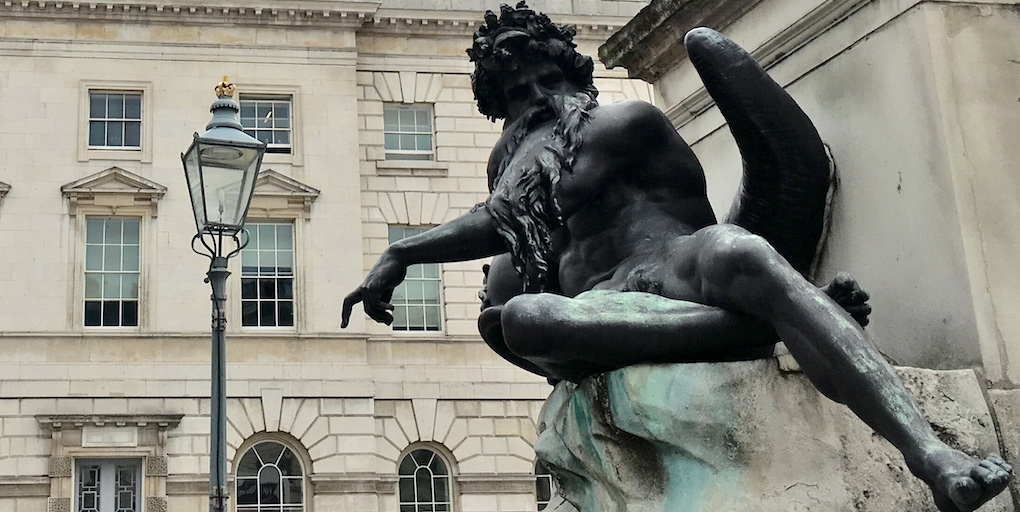
A Wind of Tingling Fullness on the Strand: Sir William Chambers’ Sculptural Design and Somerset House as ‘the object of national splendor’
An Interview with Professor Michael Trapp, Department of Classics, King’s College London
By Freya Zhang
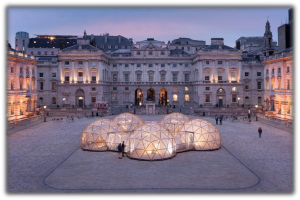
The Somerset House courtyard, with Michael Pinsky’s Pollution Pods, April 2018.
In her essay ‘The external sculptural decoration of Somerset House: And the documentary sources’, Susan Jenkins writes:
“It is clear that Sir William Chambers planned a sustained and sophisticated iconographical program for the external sculptural decoration of Somerset House, which was intended to promote England’s position as an important maritime power and advertise the government offices of the Navy.” (p. 27)
This led me to want to find out more about how Chambers’ design symbolises ideas of national pride. A detailed analysis of particular sculptural features of this 18th-century neoclassical building can help us think about how the whole of Somerset House is designed to inspire pride and awe in what was the British Empire.
I reached out to Professor Michael Trapp (who is an expert in classical studies, particularly ancient Greece and Rome) to discuss a few of the major sculptures in Somerset House. We discussed John Bacon’s statue of George III, the ‘river face’ keystones, and keystones that may represent the ‘spirit of the place’ designed by Chambers.
I hoped that, with Michael as a guide, the mysterious stories hidden behind these sculptures would unveiled themselves in a form that satisfied my desire to learn more about the culture of London and the United Kingdom in general.
John Bacon’s bronze statue of George III
(1789, the single free-standing statue in the courtyard)
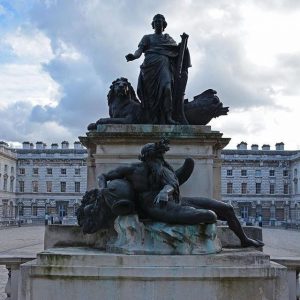
John Bacon’s statue of George III
Freya Zhang (FZ): Let’s begin with John Bacon’s bronze statue of George III, found in the Somerset House Courtyard.
In this statue, Bacon depicts the king adopting the pose of an imperial admiral dressed in a toga. Why would an 18th century statue make use of these neoclassical design elements, drawing on ancient Rome?
Michael Trapp (MT): It’s immediately obvious that George is being portrayed as a Roman leader because he’s dressed in a toga. But it’s worth also noting that this is the dress of a peacetime leader, not that of a wartime leader (general or admiral), who would be shown wearing a breastplate.
George does indeed have emblems of power and strength on either side of him – the lion (King of the Beasts, the most powerful animal, and also part of the royal Coat of Arms) and the very aggressive-looking warship prow, with its jutting ram. But this is power at rest, after victory (the ship’s prow was used in Roman times as a trophy commemorating victory, most famously attached to the speaker’s platform, the rostrum, in the Roman forum).
The other elements in the design likewise point to the fruits of peace won by successful use of power: the cornucopia (horn of plenty) below George, behind Father Thames, and the steering-oar (or rudder) that George holds, which symbolises wise government (‘government’ means literally ‘steering’) and good fortune. This kind of message was even clearer in the original form of the statue, in which George also held an olive-branch in his right hand, symbolizing peace.
And all of this still keeps us in the frame of Roman symbolism – Emperors liked to have themselves portrayed on coins with either or both of steering-oar and horn of plenty, so they would be associated with prosperity, good fortune, and wise steering of the state.
FZ: When the statue was finished in 1789, George III was 51 years old. But in the style of the Augustus period of Roman sculpture (63BCE-14CE), we see him as an idealized youth. Clearly, this is art as political propaganda. Meanwhile, the rivergod sitting beneath the youthful king is depicted as a reverend old man whose body is also idealized in a masculine way.
What messages do you think such a combination of idealized youth and age deliver, regarding the monarchy system of England and naval theme of the sculpture? And what kind of aesthetic response was such a combination trying to provoke?
MT: I suppose one reason the rivergod underneath is old is that he is always known as old Father Thames. And the river has been there since forever, they go back and back in time. So one thing that it has been celebrated there is the age, the history, the depth of history the river, and therefore the city and kingdom, has. And its fertilizing resources are water, its great river goes back in the midst of times, back into the past, so this is not a new kingdom, not some shifting institution that just appeared very recently.
As you say you’ve got the contrast with the youthful king. Well, an old kingdom needs constant regeneration, it needs the next generation of wise monarchs, it needs the vigor of youth, and I suppose that is something that you could read out of the combination here, that what we’ve got is that ideal combination of immemorial antiquity and resources of wealth that go with that; and the fresh energy and wisdom of the new monarch. A Roman emperor would often be represented as a youthful figure, the youthful Augustus. In Roman guise, the British ’emperor’ becomes the successor to the power of Rome.
Mask keystones on the Strand façade of Somerset House
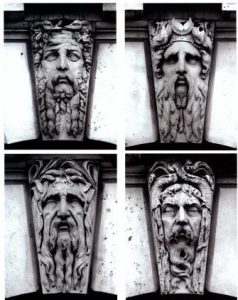
Somerset House Keystones, via Susan Jenkin’s article. Clockwise from top left: Thames; Ocean; Dee; Severn.
FZ: Susan Jenkins writes how the keystones on the Strand side of the building represent English rivers and the ocean. Could you tell a little of the history behind these keystones? What makes them so appropriate for Somerset House?
MT: Firstly, it is very clear that the sculptors have made a very definite effort to make the different rivers look different: their facial features are different, but also, the things draped around their heads – on their heads down the side – are different.
Those features are trying to say something about the different characters of the rivers. Some rivers have the reputation of being rougher, flooding more frequently, doing more damage, so those ones will be depicted as ‘angry’. Other rivers are more placid – they have more of a reputation for producing the water that irrigates the crops.
An interesting example is the River Medway, who is on the right hand side of the Ocean keystone. If you look close, you will see that he has a kind of hat that is in the form again of a prow of a ship. This is because along the Medway was one of the principle royal navy shipyards – the Chatham Dockyard in Kent. So the Medway has got a warship on his head to show he has an association with the building of the ships which British naval power depends.
But the Medway also has an arrangement around his head which includes hops, which are used in the making of the beer. And Kent is traditionally one of the parts of England where hops in particular are grown. It used to be a great activity that people in the summer and autumn would go out from London to pick the hops for some casual income. So Kent is where you get the material used for making British beer, and you get the great British warship from the River Medway.
As for the ‘River Ocean’ figure, he is the river that encircles the whole world. So he is simultaneously a river and an ocean-like body of water: River Ocean is the father from which all other rivers are born. When you put eight English rivers and Ocean together, you’re making another powerful statement about how the power and the paternity of the River Ocean is best represented in the rivers of England. And then turning the other way around, the rivers of England connect England with any sea anywhere. The rivers connect the country to the great world of the seas outside, and that is particularly important to a kingdom that sees itself as a maritime power.
FZ: The old man embodying the River Severn stands out to me, with his face being more sullen and obstinate than the rest. Why do you think the River Severn is interpreted in this way?
I think I have a possible answer for that. The Severn is a river that actually runs between two kingdoms. It runs from Wales into England. In fact, many years before this version of Somerset House was built, back into the beginning of 17th century, in the old Somerset House, there was another statue of the River Severn, and it had an inscription, which is all about the damage the River Severn does when it flows from Wales to England, ‘When I rise in spate, I soundly punish them.’
I think that another reason supporting the notion of the River Severn as an angry river, is that it has a famous phenomenon called the Severn Bore – a high tide that flows along the river, and sometimes floods. So it makes sense that Severn is shown as a grumpy river in the depiction here.
The three ‘Genius Loci’ masks
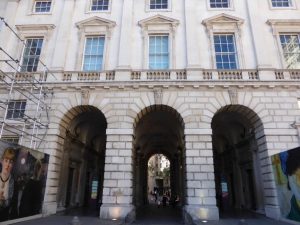
Somerset House ‘Genius Loci’ Keystones.
FZ: Facing the statue of George III, we see three masks within the keystones. I have read that they represent ‘GENIUS LOCI’, which means ‘a spirit of the place’. What is the meaning of the masks, and why did Chambers choose to include them here?
MT: I think there are a number of reasons, but here’s one very simple reason: there’s a kind of symmetry at work, because the arches on the outside of the building have got masks in the keystone position. You need another set of masks inside as well for the sake of the balance. And you don’t want to repeat the rivergods, so you want something else.
I am a little bit uncertain what these actually are, I think you have to take them together with something else. Above the doorways on the two buildings on either side here, there is a male mask: a bearded male figure. Those are very interesting because it’s a heavily bearded male face, and he has round forms curling around the ears on either side, and that implies that he is a Greek or Roman God Jupiter.
This seems to be a version of Jupiter worshipped in Egypt known as ‘Jupiter Amun’, who was the patron of an Oracle, that is is to say, a place where the gods will speak to you and tell you truth that normally human beings cannot know. So I think some of the masks on this building are to do with difficult buried wisdom. That would fit with the fact that this building was the building for learning, the building that had the Royal Academy, and Royal Society.
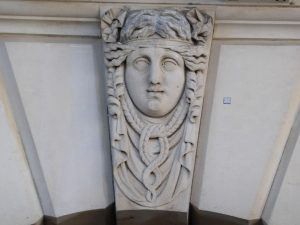
A close up of a keystone in the Somerset House courtyard, showing a ‘Genius Loci’ design.
But that still leaves with you the question of what these three female heads are in the middle of the building. Like the rivers, they have got something curling around their heads, it looks like corn to me, and I wonder whether these masks represent agricultural fertility?
But I’m really not certain about that, and I think that ‘genius loci’ is a kind of blank cheque, because ‘genius loci’ just means ‘the spirit of the place’, and that’s rather unhelpfully vague on its own. This is after all a particular place with a particular identity, so it ought to be possible to be more precise. But the published record doesn’t help us there, there’s nothing that says this is meant as, for instance, the goddess of crops.
However, although there’s no direct symbolic relation between the crops and navy, there IS a relation to what we’ve got in the courtyard. This was not just the official home of the administration of the Royal Navy, it was also where the Navy’s food supply was administered. The office of the duchy of Cornwall was also housed here, and Cornwall was one of the major agriculture and animal producing areas of the country.
And in fact, on one side of the main courtyard, those sculptures are very definitely to do with livestock, corns and crops, and agricultural fertility. So we’ve got the idea of learning, secrets, naval power, and we also have got the idea of agricultural wealth.
Stand on the Strand, and listen to the sculptures
It was an extremely great honor to speak with Professor Michael Trapp about the architectural symbols Sir William Chambers designed for the Somerset House.
We can appreciate how the navy theme of Somerset House is shown externally through the sculpture. The depictions of King George, Father Thames and other river god masks can be thought of as the ‘cantus firmus’ of the building, carrying a continuous theme around the courtyard.
Knowing the stories behind the symbolism of learning and agricultural prosperity adds for me a savory richness to understanding how Somerset House represents national pride in maritime military power. The detailed stories behind the masks of the building tell us more about how the United Kingdom wanted to be seen and celebrated: from the harsh temper of River Severn through its Severn Bore, to the hops sculpted on the head of River Medway which interestingly indicate the drinking culture of England.
Perhaps the most pleasant result of this interview is, when I go back to Somerset House, I am able to sense a tingling fullness hidden behind the silence of these sculptures that were designed in the 18th century. Such a fullness is a fullness of life that never fades away, a life that always invites you in if you really hold your breath and stand here, on the Strand, the very centre of the city of Westminster, and listen.

[…] In August 2019 Freya interviewed Professor Michael Trapp, from the Department of Classics at King’s College London. You can read their discussion of Sir William Chambers’ design of Somerset House. […]
What about the odd “mermadoid” androgynous inter-racial figures around in walls? Surely worth someone commenting on? Or is it too risky in today’s #woke world to offer an opinion?
Cognitive Constellations: Charting Mental Stars